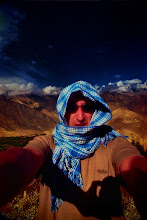Friday 29 May 2009
NEPAL
mali

Once in Katmandu, the initial idea was to get into Tibet through the unique border between Nepal and China. After a long and intensive search, it came up that the border was closed to individual travellers, due to political problems, that was the official version. More probably, because of problems caused by former travellers, who interfered with the Chinese administration policies, of the occupied region. Because of some, others carry the consequences.

the road after Jiri
These are mechanisms that aim to make tourists or travellers form groups of four people, at least, which will be accepted by the Chinese authorities, obviously for being easier to control than individuals. To these groups a guide, a Land Rover, are attributed by the travel agents, and of course at a price that will beat all records. The guide will be in charge to give not to much freedom of movement, in order to let no one interfere with the affairs considered internal by Beijing. I tried to stick to a group of Americans , who were at the Chinese embassy, but the Americans were not in the mood.
sete
So I forgot the Tibetan hypothesis, for being impracticable, and decided to take a closer look at the snow mountains. From the sparse information I had with me, the best option and the closer that I could get was called Jiri. Jiri was the starting point for Everest expeditions, before the airport at Namche Bazaar was built.
From Jiri, you can get a straight walk of 20 or more days to the fifth base camp of mount Everest, or put in other word the foot of the mountain. Hillary, the first to get to the top of the Everest, came out of Katmandhu, I don't have the exact figures but it must have taken more than a month walking. Nowadays, the Namche Bazaar airport, located near the mountain, shortens the initial trail, and offers an aerial base to the expeditions to the highest peak of the world.

In Jiri, I've met Yves, a traveller of Belgian nationality, who looked a bit lost at the time. He told me that he started the above mentioned trail with a Nepali guide, and that he had asked him his payment in advance. It happened that after a week of walking, the fellow had spent all his money in drinks, paying rounds to friends he 'd found at the different stages.

kenja
He had to come back because Yves didn't want to pay for more. It was during these desperate times that I've found him.After a conversation, we decided to hit the road without any guide. We left part of the weight from our backpacks at the lodge, and followed the same trail he had first taken.

lamajura (3500)
The first day is the most difficult, you can consider it the warming period. I remember seeing Yves waiting for me at the top of the way, at our first stop in Deurali, the pass that leads to the other region, to Bandar.
The walk, the trekking can be compared to a job, you wake up, and at 8 o'clock you start to walk, that is until 17, 18h when you feel like, and after deciding democratically. Anyway, I only was left behind during the first day, after that he started to feel the drinks and the cigarettes at Brussels Grand Place. Why should I excuse myself?

deurali
We stayed at Deurali during the first night, and the following day we went down towards Bandar. I had in mind the 3500m of Lamajura, a bit further ahead, but when we got there, it was a mountain pass on a flat extension of some kilometres, the place was covered by fog, or better we had our heads in the clouds.
Willing to compensate the loss of landscape and the humidity of the event, we've chosen a cosy place with big cushions and carpets, in order to taste the local stews.
We walked like that during three days, enjoying the local delicacies, until Jumbesi, where we decided to take a day off.

These are the mani stones, engraved with prayers, inscriptions and sketches, and other religious ornaments. They are found all through the way, and should be circunambulated from the left side. These are found in Deurali.




After some "exploring" of the surroundings, I've found a field covered with prayer flags, you can find them in all regions dedicated to Tibetan Buddhism. The wind should carry the writings on the flags and take the prayers to every place.

This is a view I got, looking back at the way we'd done so far. It should be in Jiri's direction.
bandar

In bandar, we've found a empty small temple, colourful and full of religious paintings. Demchog, protectors and other irate manisfestations of the deities. Well, Demchog is older than Tibetan Buddhism itself and supposedly subjugated by the guardians of the faith.



jumbesi

The arrival at Jumbesi was something to remenber, the small hamlet is situated in a lush green valley, itself the starting point for numerous treks in the region, namely to monasteries and Buddhist villages. Unfortunately, it was covered by heavy clouds and I remenber it surrounded by at least one high snow peaks.


